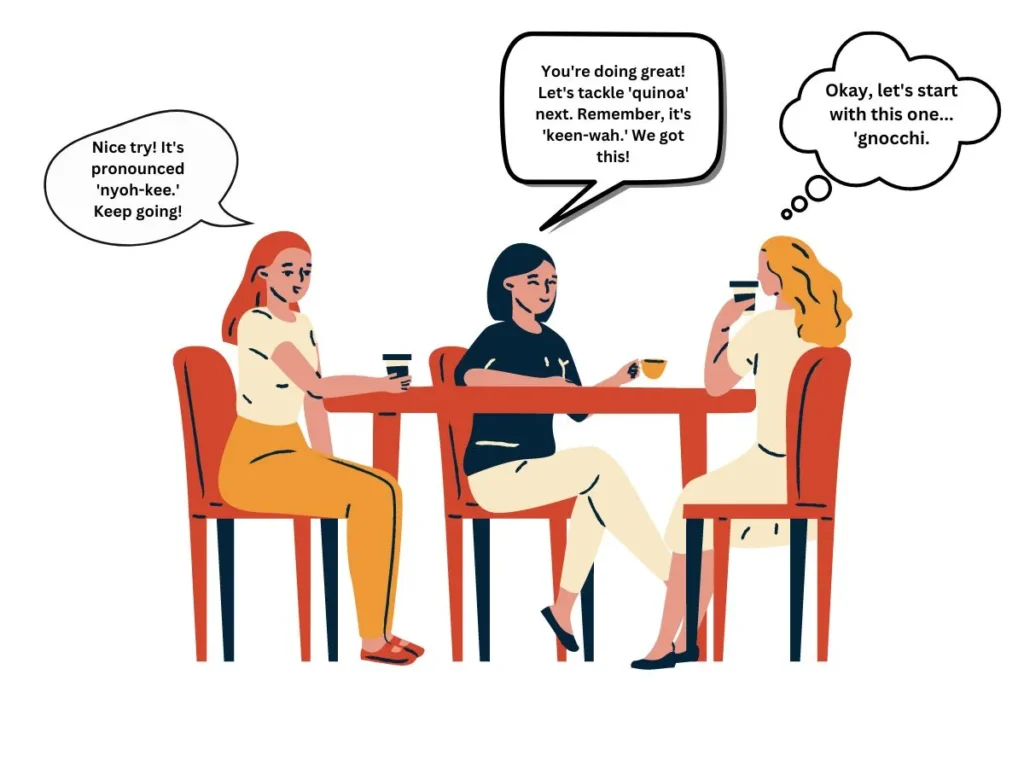Walking into a fancy restaurant, one is immediately struck by the ambiance: the soft lighting, the plush seating, and the air of sophistication. It’s an experience that many aspire to, seeking not just a meal but a culinary journey. However, as one peruses the menu, a daunting challenge arises: how to pronounce dish names at a fancy restaurant with confidence and finesse.
Proper pronunciation isn’t just about sounding sophisticated; it’s a mark of respect for the culinary traditions and cultural heritage behind each dish. Whether it’s a classic French delicacy or a modern fusion creation, pronouncing dish names correctly demonstrates a deep appreciation for the artistry and craftsmanship that goes into creating them.
For many diners, the fear of mispronunciation can be a barrier to fully immersing themselves in the fine dining experience. However, rather than letting this fear hold you back, embrace it as an opportunity for growth and learning. By adopting a mindset of curiosity and humility, you can transform mispronunciations into valuable learning experiences, enriching your culinary journey in the process.
Understanding the Basics of Pronunciation
Role of Phonetics: At the core of pronunciation lies phonetics, the study of speech sounds. Understanding phonetics is like having a roadmap for navigating the intricate terrain of language. By breaking down sounds and syllables, phonetics provides a systematic approach to mastering pronunciation. Whether it is deciphering the subtle nuances of vowel sounds or tackling tricky consonant combinations, phonetics equips us with the tools we need to pronounce dish names with confidence and accuracy.
Common Pronunciation Pitfalls: In the world of language, countless pitfalls can trip up even the most seasoned linguist. One of the most common challenges in pronunciation is the presence of silent letters. These sneaky little characters lurk within words, silently influencing their pronunciation without making their presence known. From the silent “p” in “receipt” to the silent “t” in “ballet,” mastering these silent letters is key to pronouncing dish names correctly.
| Food | Correct Pronunciation |
| Gyro | YEE-roh |
| Acai | ah-sigh-EE |
| Chipotle | chi-POAT-lay |
| Sriracha | see-RAH-chuh |
| Quinoa | KEEN-wah |
| Gnocchi | NYOH-kee |
| Worcestershire | WUSS-tur-sheer |
| Bruschetta | broo-SKEH-tuh |
| Pecan | pi-KAHN |
| Pho | fuh |
Another common pronunciation pitfall is unfamiliar consonant combinations. In many languages, certain consonants have unique sounds when paired together, resulting in combinations that can be difficult for non-native speakers to pronounce. For example, the “gn” in “gnocchi” or the “sch” in “schnitzel” can pose a challenge for those unfamiliar with their pronunciation rules. By familiarizing ourselves with these combinations and practicing them regularly, we can overcome these obstacles and pronounce dish names with ease.
Accent Marks and Their Significance: When it comes to pronunciation, accent marks play a crucial role in indicating the stress and intonation of words. In languages like French and Italian, accent marks can completely change the pronunciation and meaning of a word. For example, the acute accent in “café” indicates that the stress falls on the final syllable, while the grave accent in “pâté” signals a different pronunciation altogether. By understanding the significance of accent marks and familiarizing ourselves with their usage in different languages, we can navigate the diverse culinary influences present in fancy restaurant menus.
Exploring Pronunciation Etiquette
Embracing Humility: One of the most important aspects of pronunciation etiquette is embracing humility and overcoming the fear of judgment. It is natural to feel self-conscious when pronouncing unfamiliar words, especially in a fancy restaurant setting where sophistication is often valued. However, it is important to remember that everyone makes mistakes, and humility is key to growth and learning. Instead of letting the fear of judgment hold you back, approach pronunciation with an open mind and a willingness to learn from your mistakes. By embracing humility, you will create a more positive and supportive environment for yourself and those around you.
Honoring Cultural Differences: Another essential aspect of pronunciation etiquette is honoring cultural differences and respecting the origins of culinary traditions. Many dish names have deep cultural significance, rooted in the history and heritage of their respective cuisines. By taking the time to learn how to pronounce dish names correctly, we show respect for the cultures from which they originate. Additionally, pronouncing dish names accurately helps preserve their authenticity and integrity, ensuring that they are represented in the truest form possible. Whether it is mastering the pronunciation of French classics like “coq au vin” or Italian favorites like “bruschetta,” honoring cultural differences is essential for fostering appreciation and understanding in the world of fine dining.

Engaging in Conversation: Pronunciation isn’t just about saying words correctly; it’s also about engaging in meaningful conversation and fostering cultural understanding. When dining at a fancy restaurant, don’t be afraid to engage with the staff and fellow diners about pronunciation. Use it as an opportunity to learn more about the dish’s origins, ingredients, and preparation techniques. Ask questions, share your own experiences, and enjoy the camaraderie that comes from exploring the intricacies of language together. By using pronunciation as a bridge to cultural understanding, you’ll not only enhance your dining experience but also deepen your appreciation for the diverse culinary traditions that enrich our world.
How To Pronounce Dish Names At A Fancy Restaurant Effectively?
Research and Preparation: In today’s digital age, a wealth of resources is available at our fingertips to aid in pronunciation mastery. Online dictionaries, language learning websites, and mobile apps offer a plethora of tools and exercises designed to improve pronunciation skills. These resources often provide audio recordings of native speakers pronouncing words, phonetic spellings, and interactive exercises to help reinforce learning. By dedicating time to research and preparation using these online resources, we can build a strong foundation for mastering the pronunciation of dish names at fancy restaurants.
Practice Makes Perfect: As the saying goes, practice makes perfect, and this holds true for pronunciation mastery as well. One effective technique for improving pronunciation is to practice pronouncing difficult words aloud. Start by breaking down the word into its individual syllables, focusing on each sound and how it flows together with the others. Repeat the word multiple times, gradually increasing speed and fluency. Record yourself speaking and listen back to identify areas for improvement. Additionally, practicing with a language partner or tutor can provide valuable feedback and encouragement along the way.
Seeking Guidance: When dining at a fancy restaurant, don’t hesitate to leverage the expertise of the restaurant staff and sommeliers. These individuals are often well-versed in the pronunciation of dish names and can offer valuable guidance and assistance. If you’re unsure about how to pronounce a particular dish, don’t be afraid to ask your server or sommelier for help. They will appreciate your effort to pronounce dish names correctly and may even provide additional insights into its origins and preparation. By seeking guidance from restaurant staff and sommeliers, you can enhance your dining experience and expand your knowledge of culinary pronunciation.

How can common challenges be overcome?
A. Handling Unfamiliar Ingredients and Regional Dialects
One common challenge in pronouncing dish names is encountering unfamiliar ingredients and regional dialects. Many fancy restaurants feature dishes that draw inspiration from diverse culinary traditions, incorporating ingredients and flavors that may be unfamiliar to diners. Additionally, regional dialects can influence the pronunciation of certain words, adding an extra layer of complexity. To overcome this challenge, take the time to familiarize yourself with the ingredients and regional variations present in the dishes on the menu.
Research pronunciation guides and listen to audio recordings of native speakers to gain insight into how these words are pronounced in their original context. By understanding the ingredients and regional dialects associated with fancy restaurant cuisine, you will be better equipped to pronounce dish names with confidence and accuracy.
B. Dealing with Tongue Twisters
Another common challenge in pronunciation is dealing with tongue twisters – words with complex phonetics that can be difficult to pronounce. Whether it’s a string of consonants or a series of vowels, tongue twisters can leave even the most seasoned linguist tongue-tied. To tackle these tricky words, break them down into smaller, more manageable segments and practice each segment individually. Focus on mastering the correct pronunciation of each sound before attempting to pronounce the word as a whole. Additionally, try using tongue twisters as a fun and challenging exercise to improve your pronunciation skills. With practice and persistence, you’ll be able to conquer even the most formidable tongue twisters with ease.
C. Handling Mistakes with Grace
Finally, it’s important to remember that mistakes are a natural part of the learning process, and handling them with grace is essential for maintaining confidence and composure. If you find yourself struggling to pronounce a dish name or make a pronunciation slip-up, do not panic. Instead, take a deep breath, acknowledge the mistake, and gracefully correct yourself. Avoid dwelling on the error or letting it overshadow the dining experience. Remember that everyone makes mistakes, and most people will appreciate your effort to pronounce the dish name correctly. By handling mistakes with grace and humility, you’ll not only recover from pronunciation slip-ups with ease but also demonstrate maturity and confidence in the face of adversity.
Practical Tips for Success
Breaking Down Words into Syllables
The Key to Unlocking Pronunciation
- Identify the syllables: Start by breaking down the word into its individual syllables. Look for vowel sounds and consonant clusters that form the basis of each syllable.
- Practice each syllable separately: Pronounce each syllable slowly and deliberately, focusing on the correct pronunciation of each sound.
- Blend the syllables together: Once you’re comfortable with pronouncing each syllable individually, gradually blend them together to form the complete word.
- Repeat and reinforce: Practice saying the word multiple times, paying attention to the rhythm and flow of the syllables. Repetition is key to mastering pronunciation.
Mnemonics and Memory Aids
Creating Mental Tricks for Tricky Terms
- Create visual associations: Associate the pronunciation of a word with a vivid mental image or scene. This can help reinforce the correct pronunciation in your memory.
- Use rhymes or wordplay: Create rhymes or wordplay to help remember the pronunciation of difficult words. For example, you could create a catchy rhyme or phrase that encapsulates the sounds of the word.
- Break it down: Break the word into smaller, more manageable parts and create mnemonics for each part. This can make it easier to remember the pronunciation of the word as a whole.
- Practice regularly: Incorporate mnemonic devices into your regular practice routine to reinforce your memory and improve retention.
Embracing Confidence:
Projecting Assurance Even in the Face of Uncertainty
- Practice assertive body language: Stand tall, make eye contact, and speak with conviction. Projecting confidence in your demeanor can help you feel more assured in your pronunciation.
- Focus on your breath: Take deep breaths to calm your nerves and center yourself before attempting to pronounce a difficult word. Controlled breathing can help alleviate anxiety and boost confidence.
- Visualize success: Visualize yourself confidently pronouncing the word before you attempt it. Positive visualization can help build confidence and reduce self-doubt.
- Celebrate progress: Acknowledge and celebrate your achievements, no matter how small. Each successful pronunciation is a step forward on your journey to mastery.
Can I Practice Pronouncing Dish Names Before Going to the Restaurant?
Role-Playing Scenarios
- Choose a scenario: Create hypothetical dining situations with friends or family where you practice pronouncing dish names. This could involve pretending to order from a menu or engaging in casual conversation about food.
- Receive feedback: Ask your companions to provide feedback on your pronunciation. Encourage them to correct any errors gently and offer suggestions for improvement.
- Make it fun: Turn pronunciation practice into a game or challenge to make it more engaging. Create rewards for successful pronunciations or incorporate humorous elements to lighten the mood.
- Practice regularly: Incorporate role-playing scenarios into your regular routine to ensure consistent practice and improvement.

Are There Any Phonetics Techniques I Can Use to Master Difficult Sounds?
- Focus on specific sounds: Identify the specific sounds or phonetic combinations that you find challenging and focus on practicing them individually.
- Mimic native speakers: Listen to recordings of native speakers pronouncing the difficult sounds and try to mimic their pronunciation as closely as possible.
- Break it down: Break down the sound into its component parts and practice each part separately. Gradually blend the parts together to form the complete sound.
- Use visual aids: Use diagrams or visual representations to help you understand the articulation of difficult sounds. This can provide a helpful visual reference as you practice.
How Can I Build Confidence in Pronouncing Dish Names Aloud?
- Start small: Begin by practicing pronouncing simple dish names and gradually work your way up to more complex ones as you build confidence.
- Positive affirmations: Use positive affirmations to boost your confidence and self-belief. Remind yourself that it’s okay to make mistakes and that each attempt is an opportunity for growth.
- Record yourself: Record yourself pronouncing dish names and listen back to identify areas for improvement. Hearing your progress can boost confidence and motivation.
- Celebrate successes: Celebrate each successful pronunciation, no matter how small. Recognize your progress and pat yourself on the back for your efforts.
Are There Any Tips for Handling Mispronunciations Gracefully in a Restaurant Setting?
What Should I Do If I Mispronounce a Dish Name in Front of the Waitstaff or Chef?
- Stay calm and composed: If you mispronounce a dish name, resist the urge to panic or become flustered. Remember that everyone makes mistakes, and the waitstaff or chef are unlikely to judge you harshly.
- Correct yourself politely: If you realize your mistake, simply correct yourself in a polite and understated manner. For example, you could say, “I’m sorry, I mispronounced that. Could you please correct me?”
- Seek clarification if needed: If you’re unsure of the correct pronunciation, don’t hesitate to ask the waitstaff or chef for clarification. They will likely appreciate your effort to pronounce the dish correctly.
How Can I Politely Ask for Assistance with Pronunciation Without Feeling Awkward?
- Be honest and direct: If you’re unsure of how to pronounce a dish name, it’s perfectly acceptable to ask for assistance. Approach the situation with honesty and humility, and don’t be afraid to admit that you’re unsure.
- Use respectful language: Politely ask the waitstaff or chef for assistance with the pronunciation, using phrases like, “Could you please help me pronounce this dish?” or “I’m not sure how to say this correctly. Could you assist me?”
- Express gratitude: After receiving assistance, be sure to thank the waitstaff or chef for their help. Expressing gratitude shows appreciation for their patience and willingness to assist you.
Any Strategies for Recovering from Pronunciation Mishaps with Poise?
- Laugh it off: If you mispronounce a dish name, don’t take yourself too seriously. Laughing at your mistake can help diffuse any tension and make the situation less awkward.
- Apologize gracefully: If you mispronounce a dish name in front of others, apologize gracefully and move on. Dwelling on the mistake will only draw more attention to it.
- Use it as a learning opportunity: View mispronunciations as valuable learning experiences rather than embarrassing blunders. Take note of the correct pronunciation and use it as an opportunity to improve your skills for the future.
Conclusion
As we reflect on our journey on How to Pronounce Dish Names at a Fancy Restaurant, let’s take a moment to celebrate our progress. From initial mispronunciations to confident articulations, each step forward represents a triumph over uncertainty and a commitment to growth. Let us acknowledge the strides we’ve made and continue to embrace the learning process with optimism and determination.
Pronunciation is not just about saying words correctly; it’s about delving into the rich tapestry of culinary traditions and cultural heritage that each dish represents. Through our pronunciation journey, we have uncovered not only new words but also new flavors, textures, and experiences. Let’s savor the joy of cultural exploration and relish the opportunity to expand our culinary horizons with each correctly pronounced dish name.
As we bid farewell to our exploration of pronunciation at fancy restaurants, let’s extend a word of encouragement to our readers. Whether you’re a seasoned diner or a newcomer to the world of fine dining, embarking on the pronunciation journey with confidence and enthusiasm can unlock a world of culinary delights. Let’s inspire one another to approach each dish name with curiosity, humility, and a sense of adventure, knowing that every attempt brings us one step closer to mastery.
In closing, may our pronunciation journey serve as a reminder that the pursuit of excellence is not without its challenges, but the rewards are well worth the effort. Let’s raise a glass to the joy of pronunciation, the beauty of cultural exploration, and the endless possibilities that await us at the table.
FAQ’s
How do I know if I’m pronouncing a dish name correctly at a fancy restaurant?
One way to gauge if you’re pronouncing a dish name correctly is to listen carefully to how the server or restaurant staff pronounce it when they present the menu or describe the dish. You can also discreetly observe how other diners pronounce the same dish if it’s being ordered at nearby tables. Additionally, some upscale restaurants may provide phonetic spellings or pronunciation guides on their menus or on their websites to assist patrons.
Are there any resources or techniques I can use to improve my pronunciation of fancy dish names before dining out?
Yes, there are several resources and techniques you can use to improve your pronunciation of fancy dish names. One option is to look up the pronunciation of specific dishes online, where you can find audio recordings or videos demonstrating how to say them correctly. Additionally, language learning apps or websites often include pronunciation guides for foreign words and phrases, which can be helpful for mastering unfamiliar dish names. You can also practice pronouncing dish names aloud at home or with friends to build confidence before dining out at fancy restaurants.
| Visit Home | Click Here |
